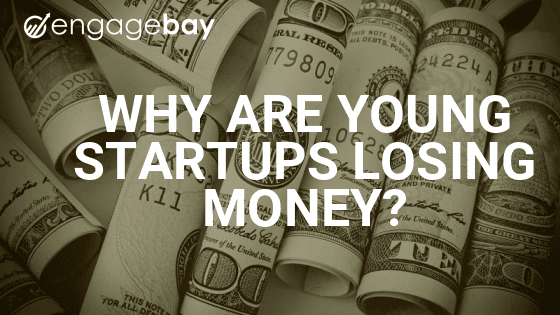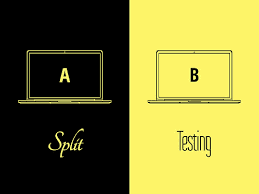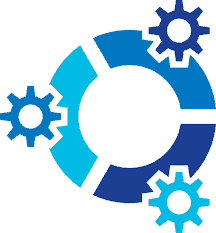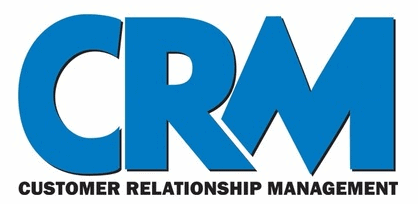Marketing is crucial. Sales team helps seal the deal and unlock revenue for the business to survive. Does it mean you will ignore all financial principles and buy every new marketing tool that comes into the market?
In today’s competitive startup economy, every company wants to more than just grow; they want to do better than their competitors.
Profit isn’t the only thing that fuels a startup founder’s fire; the ability to do so while operating efficiently, maximizing the market share and becoming the “darling of its customers” are the soft, intangible driving factors behind an entrepreneur’s desire for success.
Companies get caught in the short-term greed for numbers
So what bears the brunt of this extraordinary obsession with numbers? The budget, of course!
“You gotta spend money to make money!”, they say.
In trying to get the best possible growth hacking tools, many founders miss the due-diligence stage and get carried away by the sea of marketing terms.
When the returns come and revenues are less than expected, that’s when they realize that something went wrong.
While entrepreneurs have the subject area expertise, they are not very well equipped to tackle the intricacies of the modern-age hypercompetitive market.
Specifically, the greatest area of concern is the marketing/sales budget where entrepreneurs with less experience tend to be lenient. They don’t do enough due-diligence before purchasing marketing and sales communication tools.
Why do companies end up wasting their marketing budget?
When the revenue numbers are rising, the cushion of growth glosses over the gross wastage of budget. Revenue numbers are stable and with large amounts of investments coming in, it’s hard to stop and look back. It may give the feeling of “jinxing the momentum”.
Don’t fix what’s not broken, right?
If you go by this rule, you are going to end up with a company that does not try to control their spending.
To overcome the problem of budgetary wastage, let’s look at the root of why this happens.
They try to achieve too many goals at once a.k.a The Shiny Objects Syndrome
Many of these companies simply try to do too much with their marketing. When they don’t have an end goal or a vision they’re trying to achieve with their Marketing, they get attracted to “shiny objects”. In marketing communication, “shiny objects” are websites with sales copy so strong, they can convince you to buy things you may not need.
Because they don’t have one or two goals narrowed down, it limits their critical evaluation of the product while buying it.
The crucial missing link here is due-diligence. They don’t have a vision of how to use the tool in their marketing strategy. Their decision-making is based on how good the product “sounds” to them.
The next thing you know – they are sitting at their desk with their palms over their head, regretting that purchase!
It is possible to arrest this budget drain!
A solid marketing automation strategy is the first step. You got to be sure about where each tool belongs in your overall strategy. And your strategy needs to be strong enough to not need several tools.
You have to ask tough questions like
- Is this tool enough to help achieve my goal?
- If I achieve one goal, how does this affect other marketing metrics indirectly related to it?
- Should I invest in social media or in email marketing as well?
- Which one is better for my business at this stage – inbound marketing or outbound marketing?
If one tool does the job of many, why would you not use it?
Their focus is on tools and not customers
Marketing is done for customers to buy. Not prioritizing your customers may be a primary reason why you are not able to get the best out of your marketing budget.
A solid understanding of your customers, their needs, motivations, and problems must be documented in a customer persona. Without documentation, all you have is a set of untested approximations that only a handful of people in your marketing team are aware of.
This persona powers your marketing strategy. The tools are just an implementation vehicle!
Many early-stage, often well-funded companies, are trying to get the best out of their marketing tools, instead of trying to find the best ways to market to their customers. They lose money because they are going in the reverse direction.
They don’t test or optimize their campaigns
If you closely track your campaigns, you will know what part of the funnel is dropping the most number of leads. Once you know which part of the campaign is the culprit, you can try to tweak different elements.
A/B (Split) Testing is the name of the game here, and it has two-fold benefits.
It not only helps you refine your marketing tactics, but it also gives you an insight about your audience and how they like to be marketed to.
If you are happy with your customer acquisition cost (CAC) without any optimization in the campaign, you might be missing out on a lot of opportunities and therefore, probably wasting your budget.
How do new entrepreneurs decide which new marketing tool will be actually useful to their business?
Marketing automation evolved into existence when CRM software began to be overloaded with features that didn’t fit the traditional role of “managing the customer relationship”.
Modern marketing automation tools also have CRM features in it.
In many startups, the problem of budgetary wastage stems from lack of marketing experience. Without the knowledge of what a CRM and a Marketing Automation platform does, it compounds the problem.
There is a very little scope of saving money if both these conditions are true.
Benefits of having a Marketing Automation Tool
A marketing automation system is typically focused only on marketing tasks. It helps companies to organize, automate, and track tasks and workflows related to marketing.
This is a high-level definition.
At the low, day-to-day level, a marketing automation software will enable you to:
- Segment your email list based on customers’ preferences, problems, motivations, and their stage in the purchasing journey. Segmentation is the key to effective marketing; it ensures your marketing messages reach the right audience. It’s the difference between a bad/average marketing campaign and a good/great marketing campaign. It enables you to customize customers’ journeys based on their buying characteristics so that each segment gets a uniquely personalized As a brand, you are valued for paying close attention to each group.
- Send pre-crafted sequences of emails to each segment to nurture them. Lead nurturing is important because not every potential customer would want to buy your product/service right away. Most modern customers have done some research on the internet before buying. The job of these sequences is to nurture them into paying customers by providing a steady stream of highly-valuable content. They cultivate the interest of your company in the minds of your leads, brings them up to the buying stage, finally turning the lead into a customer.
- Enable continuous monitoring and improvement of campaigns. A marketing automation tool would also let you to measure your marketing campaigns and figure out how successful they were. Because you measured, you can then continue what’s been working. If something is not contributing to the campaign, you can replace with some other technique that works.
In short, a marketing automation tool helps you do everything from generating leads to turning them to marketing qualified leads. It also helps you improve the efficiency of your marketing operations.
When to use a Marketing Automation Tool?
A marketing automation tool should be used in these three scenarios:
- When your Sales team doesn’t have enough contacts to meet their targets.
- When you have enough high-value content and want to use it to reach to potential customers faster.
- When your email list is so large that managing it becomes a time-consuming overhead. It actually takes important time away from your Marketing team.
Once the lead is acquired, nurtured, and qualified as viable by your Marketing team, the Sales team takes over. A CRM tool will now help you convert the marketing-qualified leads into paying customers.
Benefits of having a CRM Tool
CRM system helps you manage conversations with your potential and paying customers. It captures the customers’ name and contact details in a database. It also records your interactions with each potential and paying customer over emails. Your sales agents can type the call notes and the CRM maintains an automatic call log.
By this time, the marketing automation tool has already sown the seeds of a solid relationship with your potential customers. CRM will help you strengthen this relationship by converting them into paying customers.
Your CRM system is also a crucial tool for customer retention.
At the low, day-to-day level, a CRM solution will enable your Sales team to:
- See the progress of the customer on the purchasing journey. Once they know where they where the customer stands, they can understand their purchase intent and serve important content accordingly.
- Send personalized content to convert them into paying customers.
- Quickly understand the context of your relationship with your customers and help make each conversation more personal. It will help you improve the relationship and enthuse it with much-needed mutual trust.
- Connect to social media channels and help leverage them for maximum brand recall. Your CRM can also help you drive efficient use of social media for your brand promotion.
- Improve customer relationship with the help of automated reminders on their special days like Birthdays, Anniversaries and Account Renewal dates.
A CRM helps maximize your revenue with a more personal sales and customer service approach.
You should look for effective CRM solutions if you notice any of these signs:
- Your sales and customer service strategy is beginning to overload your existing spreadsheet-based customer tracking system. If you have been using Microsoft Excel or Google Spreadsheets for far too long and want a more efficient and easy-to-use system, then you are ready to graduate to a CRM.
- Your Sales team is somehow unable to stop the leakage of leads. You may have a good number of Marketing-qualified leads but not many may convert. You should then bring in a CRM to help you monitor your Sales process and craft a more customer-focused Sales strategy.
- You want to improve your overall customer service standard. Negative brand reviews (formal or informal) can kill your brand in the modern age of the Internet. To help improve the same, bring a CRM and use it to implement customer retention strategies.
The lines between CRM and Marketing Automation Software are blurring
When several software components work together, we call it a “Stack”.
A Martech (Marketing Technology) Stack would include marketing and sales tools chained together to help you streamline, automate, measure, and improve your marketing and sales processes.
A typical martech stack includes:
- Content Management System (CMS) like WordPress or Joomla to manage the text content on your website.
- Advertising Tool like Facebook Ads Manager or Google AdWords to help you implement, measure, and optimize your outbound marketing campaigns.
- Conversion Tool that tracks user behavior on the website and performs in-depth analysis to glean insights. You would use these insights to optimize your content for conversions.
- Email Marketing Tool like EngageBay or MailChimp to help you gain new leads, nurture existing leads into customers, and turn customers into brand advocates. You would use these to create, schedule, send, track, and optimize email campaigns to help you achieve your goals.
- Customer Relationship Management (CRM) tool to help build a sustainable relationship with your customers by monitoring conversations across all channels (including phone, email, social media, etc). A smart CRM strategy accompanied by an efficient CRM tool is essential to have positive conversations with your customers. It also enables maintenance of those relationships with all your customers from within a single tool.
- Marketing Automation Software provides a full range of marketing capabilities, including email marketing, landing pages, A/B Testing Tools, and Analytics/Reporting modules.
- Social Media Management Tool like Hootsuite or Buffer to help schedule, monitor, and optimize your brand’s social media presence.
- Customer Service Tool for your support team to handle conversations and track complaints with your existing customers. The overall effect would be a higher customer service standard, which will lead to better customer retention rate and a higher number of brand advocates.
This stack will change depending on the business and industry requirements, but the categories of martech tools will remain more or less the same.
A lot of tools are combining email marketing and marketing automation with CRM to provide an all-in-one package. This is done to reduce dependencies and make managing of martech tools less tedious.
For example, HubSpot is one of the most popular inbound marketing software providing premium features for email marketing, marketing automation, social media ads, landing pages, customer service tools, and a lot more. However, along with premium tools their pricing is also premium.
Their features are geared towards enterprises with high-end Martech tools.
If a startup is using HubSpot, their utilization might be low but they would still pay the same cost.
EngageBay provides all the essential marketing tools that a growing business would need at a cost they can afford. You get a world-class email designer, a full suite for all kinds of email marketing and landing pages, and other marketing automation tools essential to take the load off your marketing team.
The problem with having too many Marketing and Sales tools
You must have heard about the saying “Too many cooks spoil the broth”. Well, something like that happens when you buy too many tools while trying to achieve too many Marketing and Sales goals.
Let’s shed some light on these problems:
Information Chaos
To see what is working for your customers, you have to analyze customers’ journey from lead to customer.
To do so, you have to extract data from multiple tools: lead generation data from popup forms, then your interaction data email campaigns, conversion data from landing pages, and finally, your sales data from a CRM.
This would take a lot out of your really productive time.
But all this data belongs to one entity – your customer.
Having this data distributed within multiple tools is a lot like shipping different parts of the puzzle in different boxes. It’s scattered and inefficient; it just doesn’t make sense!
Having a unified Marketing and Sales tool brings all the pieces into one place – no more scattered data and a highly efficient process.
Inferior analysis and reporting
Because combining data from multiple tools already takes a lot of time, it doesn’t leave much time for extracting high-quality insights from the gathered data.
Moreover, a lot of times this analysis is done in Excel or a different marketing tool.
Without the CRM, the results won’t hold a strong strategic value as it’s not utilizing any of the rich data available with the CRM.
Poor customer service and lower customer retention
With your data being scattered around different tools, it takes your support agents longer than usual to get a history of the customer. An integrated CRM unites everything in one software and makes it available to your support agents at a single click.
Many times, the customers have to repeat their data with every support agent they encounter along the way. This is often a result of either an uncoordinated support team or a less-than-sufficient customer service system.
When powered by your CRM, this system reduces improves coordination dramatically. All support agents see the same data across all interactions with the customer.
Lack of personalization
Personalization makes all marketing communication better because it makes your leads/customers to notice the content. Implementing personalization without integrating your CRM is like threading a needle; it’s tedious and time-consuming.
Having a single tool that handles email marketing and CRM together makes it a breeze.
Also, because the CRM can capture multiple types of data, having a unified software means deepening your level of personalization and relevance.
Complicated and costly training schedule
If you have separate tools, you will take time in finding the right one. Then, after buying it, you must take time to train your teams on this tool. And some tools would not provide free support during onboarding; they would require you to pay extra for getting trained.
With an integrated SaaS platform, all of this is needed only once. And with a tool like EngageBay, you don’t have to pay for training – the tool itself is so easy to use.
.. And the budgets for Martech tools are soaring
In November of 2018, Gartner published the CMO Spend Survey 2018-19. The survey included responses from senior-level marketing executives from the US and UK. It gives us an idea of how Martech spending compares to other areas of the Marketing budget.
Among all of their findings, what really stood out for me was 29% of the Marketing budget went to Martech tools. And only 24% of budget expenses were for labor i.e. paying your marketing staff.
This means companies are now paying more for their Martech stack than the actual people using them.
How to calculate the costs for your own marketing automation suite
The cost of purchasing the tool is only one part of a marketing automation stack. There are many direct and indirect factors involved that decide the overall cost.
License Costs
It’s the most fundamental element of marketing automation costs. Typically, all tools are priced based on a number of contacts in your list. Before you go to buy any of these tools, make sure you have a clean email list without duplicates and invalid IDs.
Most tools (except MailChimp) offer free and highly-limited features for the first 1000 subscribers. MailChimp offers 2000 subscribers in the free plan, but with limited features.
At EngageBay, we care for small businesses and this reflects in our pricing. Although our free plan includes only 500 contacts, we provide all the features you need to start growing your business.
At $9 /user/month (our first paid plan), you get a whopping 15,000 contacts per month. This is more than any other service provider in the market.
Costs of Implementation
Creating strategies takes time. Implementing them on ALL of these tools can become an unnecessary overhead without proper training. It might even cost you money if you choose to avail the tool’s on-boarding charges.
Make sure you count this as a separate expense when setting things up. If you like these tools, you would be using them again. You wouldn’t want errors or data inconsistencies to crop up 6 months from now.
Costs of Ongoing Operation
You would include the electric bill of your commercial office in the operating expenses of your business. Costs of the human resource(s) using the tool are just the same.
If you use a complex marketing tool, you will need at least one staff member to use it and manage your campaigns and data. You may even hire a team or outsource the job to a third party.
The money you spend on outbound (social/paid search) advertising campaigns and any other recurring expense you do to operate these tools – all these cumulatively contribute to ongoing marketing automation costs.
Training Costs
If you came up with the suggestion proactively, you will also need to train your business users to help them see their benefits. Folks in the Senior management are high-level stakeholders. They will need a high-level overview of capabilities of the tools so they can help draw and direct long-term marketing plans using these tools.
Technical and onboarding training for the Marketing team is also essential. Most marketing automation tools charge a single-time onboarding fee which can range anywhere from $500 to $3000, depending on the tool and the plan you select.
All these costs have to be considered for ALL the tools you would be using (blockquote).
Things you can start doing today to save money with Marketing Automation
No matter what your current state of expense, growth is always possible through decisive and constructive steps.
Some of the ways your company can stop the overspending today are:
Create strategies first, then look for tools to implement them
Consistent with the Shiny Objects Syndrome described earlier in this post, many early-stage entrepreneurs may place emphasis on tools.
Martech tools are important, and they are the heart of any profitable marketing team.
But what good is a body with the heart but without the brain? You need both!
A smart marketing strategy devised by competent marketing professionals is as important as the brain in the human body.
You could use any of our 6 core marketing guides to refresh your fundamentals. Who knows, you might learn something to inspire you for the next campaign!
Prioritizing your customers above saving money
To successfully market your business, you have to prioritize your customers at every step. The product/service is for them, and you are doing it solve their problem and improve their lives.
Businesses can’t make money if they:
- don’t know their customers, and
- don’t stay close to their needs throughout the purchase journey
These are the two fundamental problems that businesses must solve for themselves.
If you don’t understand your customers, your product will be just an approximation of what they want. You will soon lose out to your competitors.
Knowing why your customers buy (at an emotional level) and why they don’t, really helps conduct an efficient Sales process.
You will need a solid understanding of both these questions to generate leads, convert them to customers, and to retain those customers.
Both require detailed research and are often ongoing processes. Invest based on these goals. The money will flow as a byproduct because you would have built a solid marketing base.
Optimize your campaigns to earn more money
Yet another way to increase revenue is by optimizing your campaigns. By this time, you would have already used your customer persona to design your marketing campaign strategy. By studying an ongoing campaign, you get to test those assumptions.
You will know instantly if something is going wrong and you can take steps to mitigate any major lead leakages in the campaign.
Capture your customers’ heart and soul with customer service
Once a lead becomes a customer, your job has just begun. With the help of friendly and agile customer service agents, you can make sure their life stays problem-free when using your product.
Any decent CRM will allow you to gather all customer conversations and interactions on a single screen. This is really powerful data. You can leverage this knowledge to create campaigns that are more useful to the customers. All this data also enables you to personalize your marketing messages thereby enabling higher customer satisfaction and retention rates.
If a customer has stayed with you for a longer period, you could also tap into their network by opening up an affiliate program.
How can EngageBay help you reduce your marketing automation costs?
At EngageBay, our sole mission is to help small businesses grow – affordably.
EngageBay is an integrated Marketing, Sales, and Service software tailored to the business and financial requirements of growing businesses.
We offer 4 core products
- Marketing Bay
- Sales Bay
- Service Bay
- CRM (free)
Marketing Bay is a unified marketing platform that enables you to increase your lead generation capability with the help of email broadcasts and sequences, lead capture forms, landing pages, and marketing automation workflows.
I love all of our features, but our Rich Email Editor really takes the cake. It’s so innovative and fluid; you will simply point, click, and choose your way to cool and professional design – absolutely no coding skills necessary!
Our free Sales Solution provides all the tools that your Sales team will need to help close more deals and offer a higher customer service standard.
On this screen, you get to solve customer complaints faster with our comprehensive view of all data for each customer.
Get a bird’s eye view of your entire deal pipeline for senior and senior-high management officials who want a quick refresher of the state of the deals.
Our free CRM packs great value for your sales and customer service teams to create a positive brand experience. Flawless managing of customer communication at our end allows your Sales/CS teams to freely work on providing empathetic and positive customer service experience.
See what you get with our free CRM Bay
In our Service Bay, all your customer support tickets come together and all the conversations by your support agents get tracked. Want to solve more customer service queries in less time? Put your CS time on the fast track with canned responses and service automation.
Explore what else Service Bay has to offer
If you have come this far, it means you are intrigued about one or all of our components. If that’s the case, I would invite you to start your trial from EngageBay Pricing page.
Want to refresh your marketing fundamentals? Head over to check out our Marketing Resource Guides.
Looking to switch from your existing provider? See any of our five alternative guides at the bottom-right of this page.
Concluding Thoughts
It’s easier to focus on customers rather than just trying to get the most out of your money. Brand new entrepreneurs must possess an attitude of problem-solving for the customer.
The right approach is to focus on understanding your customer in the early days and using the CRM to figure out how they like to buy. And while you are focusing on the customer, make sure you are not investing your time and effort for more than one or two goals.
Having too many goals without a defined strategy only aids the Martech chaos!
The point of this post is not to tell you that you should give up all your marketing tools and buy a single, unified marketing suite that replaces everything.
This point of this post is to make you mindful of your own marketing automation expenses. First-time small business entrepreneurs tend to learn things by doing it, we just want to you avoid any unnecessary expenses which can easily be avoided.
Contact EngageBay through our Live Chat for any more queries.






